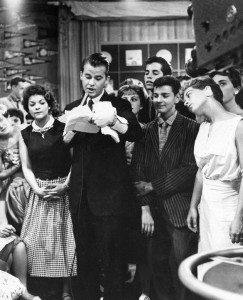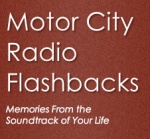TV Jock Finally Comes Into Own
NEW YORK — The TV disc jockey show is is finally coming into its own on all three audience levels — network, regional and local. Heretofore strictly a second-choice medium for record plugs, video deejay shows have recently been hailed by many record dealers as a a prime sales stimulant for new releases, both singles and albums.
ABC-TV network deejay show “American Bandstand” was the No. 1 program in its time period ( 3 to 4:30 p.m., across the board) according to the September Trendex Report. The show chalked up a 5.7 rating,with a 35.6 share of audience–62 per cent higher than CBS and 35 per cent greater than NBC. “Bandstand” share-of-audience figure was more than double that chalked up by the web in the same time period in August, prior to the airing of “Bandstand.”

The show emanates from Philadelphia and features a crowd of teen-agers dancing to current pop disks, played by deejay-host Dick Clark, was termed “the greatest stimulant to the record business we as dealers have ever known,” as stated by Raymond Hunsicker, (Tower Grove Music Store; St. Louis) representing the Dealers of Greater St. Louis. Hunsicker added: “many dealers have installed TV sets in their record departments and have extended teenagers an invitation to watch the show in their stores.”
On the regional level, the “Top 10 Dance Party,” a syndicated Victor & Richards package, is currently carried in fourteen different cities. The TV show features local deejays as emcees with a record hop format, with each station following a general programming blueprint sent out weekly by Victor & Richards.
The package, created by writer-producer Alan Sands and executive producer Vic Lindeman, Jr., include detailed outlines for games, merchandising features and contests, with Victor & Richards, providing the prizes in most cases.
In line with this, Sands is currently readying a new feature, tagged “Memento Auction,” which involves the auction of personal items of small value or gag items (such as lock of hair, etc.) donated by record artists. Money raised goes to local charities and the artists garner plugs for their disks. END.
(Information and news source: Billboard; October 7, 1957).
![]()
